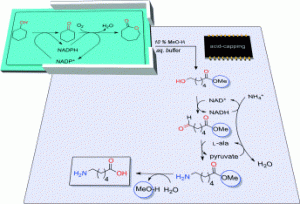Introducing an in situ capping strategy in systems biocatalysis to access 6-aminohexanoic acid

The combination of two cofactor self-sufficient biocatalytic cascade modules allowed the successful transformation of cyclohexanol into the nylon-6 monomer 6-aminohexanoic acid at the expense of only oxygen and ammonia. A hitherto unprecedented carboxylic acid capping strategy was introduced to minimize the formation of the dead-end intermediate 6-hydroxyhexanoic acid. For this purpose, the precursor ε-caprolactone was converted in aqueous medium in the presence of methanol into the corresponding methyl ester instead of the acid. Hence, it was shown for the first time that esterases – specifically horse liver esterase – can perform the selective ring-opening of ε-caprolactone with a clear preference for methanol over water as the nucleophile.


